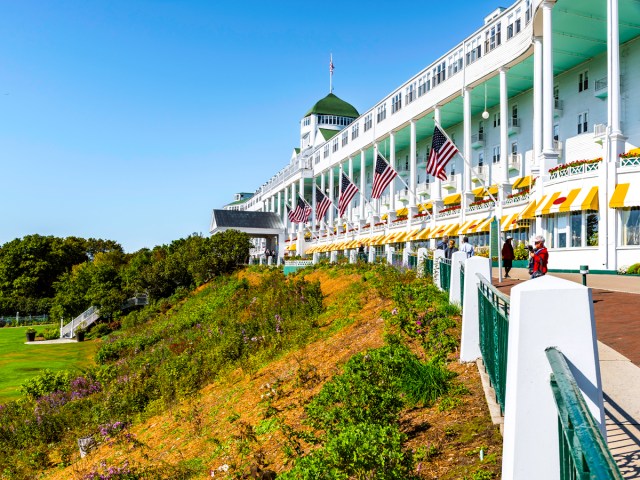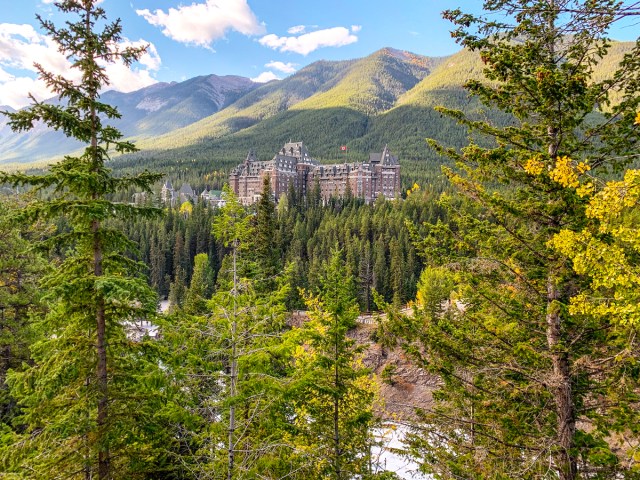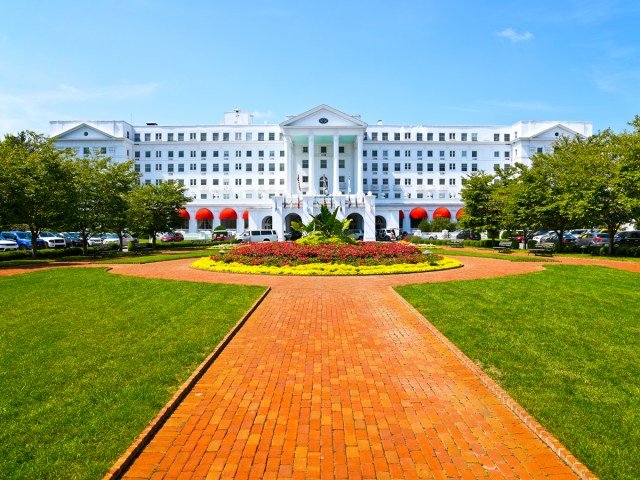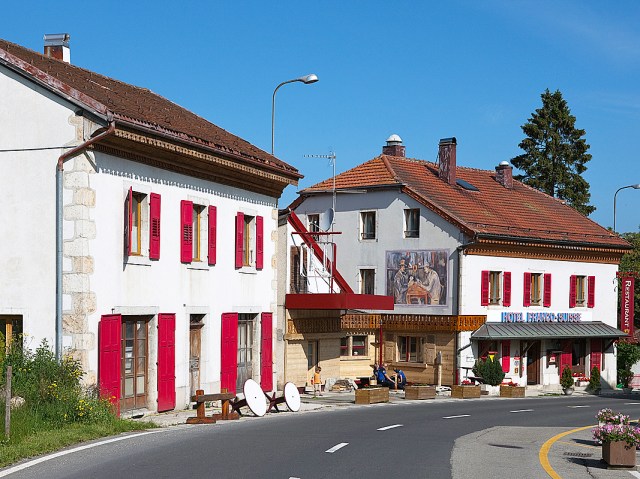Sometimes, a hotel can be much more than just a place to rest your head after a day of sightseeing. Some properties are so grand and so unique that staying there can quickly become the highlight of your vacation. From one of the tallest hotels in the world overlooking the glittering coast of Dubai to a U.S. National Historic Landmark on Michigan’s Upper Peninsula with a unique claim to fame, these nine highly unique hotels are a destination themselves.
Grand Hotel – Mackinac Island, Michigan

There’s no grander welcome to Mackinac Island (pronounced mack-in-awe) and its 4 square miles of carless tranquility than the front porch of the Grand Hotel. In fact, the hotel’s 660-foot-long front porch framed by towering white Colonial Revival columns is the world’s longest porch. It extends more than two football fields in length and is filled with dozens of rocking chairs inviting you to take a seat and gaze out over the Straits of Mackinac, located between Michigan’s two peninsulas. The hotel — a National Historic Landmark — is the crown jewel of this enchanting island. Since 1887, its guest book has been signed by five U.S. presidents, as well as luminaries ranging from John Jacob Astor III and Mark Twain to Robert De Niro and Madonna.
Open seasonally from May through October, the Grand Hotel maintains about 400 guest rooms, no two of which are alike. Each is decorated in a distinct panoply of pleasantly clashing colors and patterns. When dinner comes around, patrons are encouraged to dress for the occasion at the 14 in-house restaurants and bars. And once you’re finally ready to leave the hotel and see what the island has to offer, you might as well continue on the yesteryear theme by touring it in a horse-drawn carriage.
Fairmont Banff Springs – Banff, Canada

The grand dame of the Canadian Rockies, the Fairmont Banff Springs Hotel is set at the base of Rundle Mountain and overlooks the stunning Bow Valley in Banff National Park (Canada’s oldest national park). Clad in limestone and styled after Scottish baronial castles, the hotel was the tallest building in Canada when it opened its doors in 1888. Now with more than 700 rooms and operated by Fairmont, the property still draws visitors from around the world who come throughout the year for hot springs, skiing, golf, and pristine mountain vistas.
While the glorious natural surroundings are clearly the star of the show, they are far from the hotel’s only intrigue. Rumors of ghosts abound at the property, including one about a bride who continues to glide on the marble steps where she fell to her death on her wedding day. Room 873, the site of a grisly murder, has been permanently sealed, and guests still report receiving help from the friendly spirit of a longtime employee. Whether or not you believe in the paranormal, the hotel recently completed a $35 million renovation in 2023, turning Alberta’s “Castle in the Rockies” into even more of a showstopper.
Burj Al Arab Hotel – Dubai, UAE

One of the world’s tallest hotels, the 1,053-foot Burj al Arab was designed to emulate a massive billowing sail and sits alone on an island just off the coast of Dubai. And as with most things in Dubai, “understated” isn’t part of the vocabulary here — guests select their pillows from a menu of 17 options, 30 different types of Italian Statuario marble embellish the interior (along with over 19,000 square feet of 24-karat gold leaf), and 16 staff florists create arrangements tailored to the tastes of each individual guest.
Designed by Tom Wright, the hotel opened in 1999 after five years of construction, including two years just to build the island it sits on. Guests arrive either in a Rolls Royce via the private 1,100-foot bridge or by helicopter. (As long as there are no special events, that is — the cantilevered helipad has hosted soirees with tennis pros, star DJs, race car drivers, and Hollywood stars.) Inside, the towering atrium and exuberant decor are Arabic opulence at its finest. Each of the 202 two-story suites starts at around $1,500 per night — for people who want to visit without staying, a tour of the property will set you back about $100.
Ponce de León Hotel – St. Augustine, Florida

Before they drew blueprints for the New York Public Library, John Carrére and Thomas Hastings were the masterminds behind Hotel Ponce de León, a resplendent 540-room luxury hotel built at the height of the Gilded Age.
Located on 7.5 acres of Florida’s northeast coast, in 456-year-old St. Augustine, the hotel was funded by railroad and oil tycoon Henry M. Flagler. The Spanish-Renaissance style building features Austrian crystal chandeliers, a dazzling painted rotunda, a unique courtyard fountain that acts as a sundial, and one of the world’s biggest private collections of Tiffany stained glass. And thanks to 4,000 lights wired by Thomas Edison himself, the hotel has boasted electricity since opening in 1888 — a rarity at the time.
For eight decades, the hotel welcomed dozens of famous guests, including Mark Twain, Zora Neale Hurston, Ernest Hemingway, Babe Ruth, President Theodore Roosevelt, and teenage John F. Kennedy, who visited with his family. In 1968, the building was renamed Ponce de León Hall when it became part of Flagler College. Now a National Historic Landmark, the hall is open for daily tours.
Greenbrier Resort – West Virginia

A six-story National Historic Landmark rising from the Allegheny Mountains, the resplendent Greenbrier Resort has also had quite an impressive guest list — from Joseph and Rose Kennedy on their 1914 honeymoon to Princess Grace and Prince Rainier III on a 1963 vacation, not to mention 28 U.S. Presidents. The Greenbrier is located in White Sulphur Springs, a city named for waters that have been touted for their healing properties since a visiting woman’s rheumatism was allegedly cured in 1778. A hotel was built on the property 80 years later, and its present successor — an extravagance of classical Georgian architecture — has been welcoming guests since, save for a short period when it served as a World War II hospital.
Comprising 710 rooms and cottages, the Greenbrier extends across 11,000 manicured acres. Activities and amenities abound, from carriage rides to golf courses, 20 restaurants and lounges, a mineral spa, whitewater rafting, an aerial adventure course, a movie theater, and even workshops devoted to fairy and gnome garden landscapes. Much of the distinctive interior palette was chosen in the late 1940s by decorating doyenne Dorothy Draper, who believed “color is magic” and loved juxtapositions.
The Arctic Hideaway – Norway

What makes a luxury retreat? For some travelers, it’s the luxury of being surrounded by nothing but nature, and the Arctic Hideaway — a resort made up of 12 wood buildings on a serene, almost entirely uninhabited island above the Arctic Circle in northern Norway — might be the ultimate calling.
Opened in 2014, the Arctic Hideaway started as the brainchild of a Norwegian jazz musician as a place to reflect and create. The approach to the island, via a 75-minute ferry ride from the town of Bodø on the mainland, reveals a series of small, angular buildings on steel stilts, arranged on a hillside above the dock. Four of the buildings are called “sleeping houses,” and though they have beds for sleeping, they lack curtains. Instead, guests are issued a sleep mask upon arrival — and the views of the ocean (and sometimes the northern lights) from the private houses may convince them that curtains would be a bad idea anyway.
The remaining buildings serve various purposes — a kitchen stocked with local delicacies, a sauna, a shared studio space — and when you’re ready to leave the property, trails around the tiny car-free island provide endless entertainment (as do sprawling sunsets, fleeting visits from sea birds, and long stretches of blissful silence).
Stanley Hotel – Colorado

Even if you haven’t heard of the Stanley by name, there’s a good chance you’re familiar with its legacy — at least, if you’re a fan of psychological horror flicks. This historic hotel in Estes Park, Colorado, inspired the Overlook Hotel in Stephen King’s The Shining. Those who get the chance to stay here will find the experience quietly thrilling, particularly if you’re lucky enough to book one of the Spirited Rooms — those said to be haunted by such esteemed ghosts as Lord Dunraven, who owned the land on which the hotel was built. The most famous (and most requested) of these is Room 217, which King himself stayed in when he and his wife were the only guests at the hotel.
You don’t have to believe in ghosts to believe in beauty, however, and the Stanley is nothing if not beautiful. Opened in 1909, the landmark Colonial Revival building is set against the backdrop of the Rocky Mountains and Lake Estes. But if you’re here, you might as well embrace the hotel’s paranormal past and join one of the nighttime tours highlighting the Stanley’s many haunted tales — you may just want to sleep with one eye open.
Hotel Arbez – France/Switzerland

In 1862, to take advantage of a Napoleonic treaty that shifted the border of France and Switzerland to run directly through his property, a clever (and shifty) businessman built the edifice that would become Hotel Arbez directly on top of the borderline. On the French side of the building, he operated a bar, and on the Swiss side, a shop — an arrangement that enabled him to move smuggled goods between the countries without easy detection. During World War II, however, this handy border crossing allowed his descendants — who had converted the building to a hotel — to covertly move Jews and members of the Resistance from Nazi-occupied France to safety in Switzerland.
The hotel, about an hour north of Geneva, still serves visitors to this beautiful Haut Jura region, many of whom come to ski and hike the Jura Mountains. The hotel’s charm comes not just from its unusual location — in some rooms, guests sleep with their heads in France and their feet in Switzerland — but also from its wood-paneled decor and sturdy beamed ceilings, hand-carved furniture, and its brasserie serving rustic alpine cuisine and Jura wines.
Thornbury Castle – England

A fair number of England’s spectacular castles and manors were built or greatly transformed during the reign of the House of Tudor (1485-1603), but only one Tudor castle currently functions as a luxury hotel — giving guests the rare (and to some, unsettling) opportunity to rent the same suite King Henry VIII and Anne Boleyn stayed in during their honeymoon in 1535. Before Thornbury Castle belonged to the crown, Edward Stafford, the third Duke of Buckingham, built this fortress near Bristol in 1511. But after Stafford was executed for treason a decade later, the castle became Tudor property for 33 years, before it was returned to the Stafford family and later fell into ruins.
Renovations began in the 1850s, and Thornbury started welcoming overnight guests for the first time about a century later. Now fresh off a multimillion-dollar renovation, Thornbury Castle contains four beautifully restored dining rooms where the likes of Laurence Olivier and Sophia Loren have enjoyed sumptuous meals. Each of the 27 distinctly decorated guest rooms is named for a historical figure. (Request the Catherine of Aragon Tower Suite to sleep in the largest four-poster bed in any British hotel.) And outside the castle are 15 pristine acres fit for nobility, where guests can partake in croquet, falconry demonstrations, and archery lessons to work up an appetite for afternoon tea.
More from our network
Daily Passport is part of Optimism, which publishes content that uplifts, informs, and inspires.























